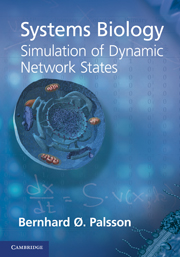Book contents
- Frontmatter
- Contents
- Preface
- 1 Introduction
- 2 Basic concepts
- PART I SIMULATION OF DYNAMIC STATES
- 3 Dynamic simulation: the basic procedure
- 4 Chemical reactions
- 5 Enzyme kinetics
- 6 Open systems
- PART II BIOLOGICAL CHARACTERISTICS
- PART III METABOLISM
- PART IV MACROMOLECULES
- APPENDIX A Nomenclature
- APPENDIX B Homework problems
- References
- Index
3 - Dynamic simulation: the basic procedure
from PART I - SIMULATION OF DYNAMIC STATES
Published online by Cambridge University Press: 05 August 2012
- Frontmatter
- Contents
- Preface
- 1 Introduction
- 2 Basic concepts
- PART I SIMULATION OF DYNAMIC STATES
- 3 Dynamic simulation: the basic procedure
- 4 Chemical reactions
- 5 Enzyme kinetics
- 6 Open systems
- PART II BIOLOGICAL CHARACTERISTICS
- PART III METABOLISM
- PART IV MACROMOLECULES
- APPENDIX A Nomenclature
- APPENDIX B Homework problems
- References
- Index
Summary
Once a set of dynamic mass balance equations has been formulated, they can be numerically solved, and thus the behavior of a network can be simulated in response to environmental and genetic changes. Simulation results can be obtained using a number of different software packages. Dynamic simulation generates the time-dependent behavior of the concentrations, i.e., x(t). This solution can be obtained in response to several different types of perturbation and the results graphically displayed. The basic principles and procedures associated with dynamic simulation are covered in this chapter. The following three chapters then apply the simulation process to a set of simple but progressively more complex and relevant examples.
Numerical solutions
Network dynamics are described by a set of ODEs: the dynamic mass balance equations; see Eq. (1.1). To obtain the dynamic solutions, we need three things: first, the equations themselves; second, the numerical values for the kinetic constants that are in the equations; and third, the initial conditions and parameters that are being perturbed. We describe each briefly.
- Type
- Chapter
- Information
- Systems Biology: Simulation of Dynamic Network States , pp. 41 - 57Publisher: Cambridge University PressPrint publication year: 2011



